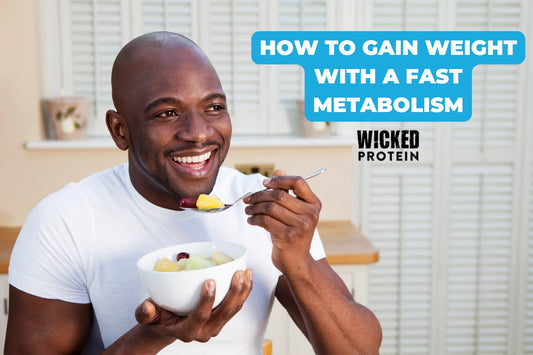
6 Easy Ways To Increase Your Protein Intake
There is a wide variety of protein powders and sources of protein out there, and it can be difficult to find a way to meet your daily protein requirements without sacrificing taste or a ton of time preparing a meal.
In this guide, we’ll list the 6 easiest ways to increase your protein intake by adding more protein to your diet.
Adding Protein Powder into Your Diet
So, you’ve picked your protein powder. Nice! Now it’s time to get creative in the kitchen and actually add it to your daily diet to make sure you’re getting the most out of it.
1. Smoothies and Shakes
One of the most popular and convenient ways to enjoy protein powder is by adding it to smoothies and shakes.
It’s really the classic go-to beverage people use their protein powders in.
You blend your favorite fruits, vegetables, milk (or a dairy-free alternative), and a scoop of protein powder for a nutritious and protein-packed beverage.
Experiment with different flavor combinations to find the perfect smoothie recipe that works best for you.
2. Protein Bars
A convenient snack you can eat on the go.
You can either purchase pre-made protein bars or make your own using protein powder, nuts, seeds, and other ingredients.
These homemade protein bars allow you to control the quality and quantity of ingredients, ensuring a healthier snack option.
And, unlike most pre-made protein bars, you know what you’re putting in your body.
3. Baking with a Twist
Who said baking can’t be healthy?
Swap some flour for protein powder in your muffins, pancakes, or even cookies.
As a result, you get a snack that is just as delicious with the added benefit of protein.
Tasty and nutritious - that’s a win-win.
4. Energy Balls
Mix protein powder with nut butter, oats, a drizzle of honey, and whatever else you like.
Roll it up, refrigerate it, and boom - homemade energy balls!
5. Protein Pancakes
Upgrade your breakfast routine with protein pancakes.
Simply mix protein powder with your choice of pancake batter, and cook as usual.
Protein pancakes are not only a delicious way to start your day but are also an easy way to meet your daily protein intake requirements without sacrificing taste.
6. Protein Oatmeal
Add protein powder to your morning bowl of oatmeal for a hearty and satisfying breakfast.
Simply stir a scoop of protein powder into your cooked oatmeal and top with your favorite fruits and nuts.
This protein-full oatmeal will keep you full and energized throughout the morning.
Understanding Protein Powder
Protein powder is a powdered form of protein that is derived from various sources such as plants (soybeans, peas, rice, potatoes, or hemp), eggs, or milk.
It is widely used in the fitness industry as a convenient way to meet the daily protein intake requirements and maximize muscle growth.
What sets protein powder apart from other protein supplements, like collagen, is its range of amino acids, making it a source of complete protein.
Amino acids are important for breaking down food, growing and repairing body tissue, making hormones and brain chemicals, and providing an energy source.
Benefits of Protein Powder
Protein powder has multiple benefits that can improve your overall health and fitness goals.
1. Muscle Building and Repair
Protein powder, especially whey protein, is rich in branched-chain amino acids (BCAAs) that are essential for muscle growth and repair.
These amino acids help stimulate muscle protein synthesis, which increases muscle mass and strength.
If your goal is to build lean muscle, you’ll probably want to look more into protein powder and consider using it in your diet.
2. Complete Protein Source
Protein powder contains all nine essential amino acids required for various bodily functions.
Unlike collagen, which is an incomplete protein source, protein powder has the upper-hand and provides more benefits which we covered in another article.
Whether you are an athlete, engaged in regular strength training, or following a plant-based diet, protein powder will make sure you get all the nutrients for improved bodily function.
3. Weight Management and Nutritional Boost
Protein powder is also great for people bulking up and people cutting fat.
It helps reduce hunger cravings and promote feelings of fullness, which is helpful when following a strict diet.
4. Diverse Use and Convenience
One of the key advantages of protein powder is its ability to mix with anything.
It can be easily mixed with water or milk, added to smoothies, or added to a variety of recipes.
This flexibility allows you to add protein powder into your daily routine, ensuring you meet your protein requirements without sacrificing taste or convenience.
Drawbacks of Protein Powder
While protein powder offers numerous benefits, it is essential to consider its potential drawbacks before adding it into your diet. Here are a few drawbacks worth noting:
1. Caloric Content
Many protein powders are relatively high in calories, which may not align with your specific dietary goals. If you are trying to lose weight or maintain a calorie deficit, it is crucial to consider the caloric content of the protein powder you choose. Opting for low-calorie protein powders or adjusting your serving size can help mitigate this concern.
2. Quality
Not all protein powders are created equal.
Some contain artificial flavorings, added sugars, fillers, or other unhealthy additives.
It is important to choose a protein brand that prioritizes quality and transparency.
Reading product labels and selecting protein powders with minimal ingredients and no unnecessary additives is key to ensuring you are making a healthy choice.
At WICKED, we use only the highest quality ingredients and are a partner of the Clean Label Project.
3. Allergies
Protein powders, derived from milk or soy, may cause allergic reactions or digestive issues in some individuals.
If you have known allergies, it is important to choose a protein powder that aligns with your dietary restrictions.
Choosing the Right Protein Powder for Your Health Goals
1. Protein Source
Protein powders are available in various sources, including whey, casein, soy, pea, rice, and hemp.
Each protein source offers unique health benefits and works better with a certain type of diet.
Here are some common protein sources:
- Whey Protein: Derived from milk, whey protein is highly regarded for its complete amino acid profile and fast absorption rate. It is an excellent choice for muscle building and recovery. At WICKED, we make only high-quality whey protein in 6 different flavors.
- Casein Protein: Also derived from milk, casein protein is a slower-digesting protein that sustains the release of amino acids. It is ideal for promoting muscle recovery during periods of prolonged fasting, such as overnight.
- Soy Protein: Mostly used by vegetarians and vegans, soy protein is a plant-based protein source that offers a complete amino acid profile. It can be an effective alternative for people on vegan diets.
- Pea Protein: Another popular plant-based option, pea protein is easily digestible and rich in branched-chain amino acids. It is an excellent choice for individuals with soy or dairy allergies.
- Rice Protein: Rice protein is hypoallergenic and easily digestible, making it an ideal option for those with food sensitivities. However, it is considered a lower-quality protein source than whey or soy.
- Hemp Protein: Derived from hemp seeds, hemp protein is a complete plant-based protein that contains all nine essential amino acids. It also offers the added benefit of omega-3 and omega-6 fatty acids.
2. Protein Quality
The protein concentration and quality of a protein powder are one of the most important things to consider when picking a protein powder.
Look for protein powders that contain a high percentage of protein per serving.
Typically, a good-quality protein powder should have at least 20 grams of protein per serving.
Additionally, go for protein powders that undergo third-party testing to ensure quality and purity.
Certifications such as Clean Label, NSF International, Informed-Choice, or USP Verified indicate that the product has been independently tested for safety and quality.
3. Additional Nutrients and Ingredients
While protein is the primary focus, it is worth considering the additional nutrients and ingredients present in the protein powder.
Some protein powders are fortified with vitamins, minerals, and other healthy nutrients, offering an added nutritional boost.
However, be cautious of protein powders that contain excessive additives, artificial sweeteners, or unnecessary fillers.
Look for products with minimal ingredients and avoid those with potentially harmful additives.
4. Taste and Texture
The taste and texture of a protein powder can significantly impact your overall enjoyment of the protein powder.
There really is no other way to know which flavor you’ll love than experimenting with different flavors and brands and finding a protein powder that you genuinely enjoy.
Consider reading reviews and seeking recommendations to get an idea of the taste and texture before making a purchase.
5. Dietary Considerations
If you have specific dietary considerations, such as lactose intolerance or gluten sensitivity, it is crucial to choose a protein powder that suits your needs.
Look for lactose-free or dairy-free options or go for gluten-free protein powders if you have sensitivities to gluten.
Additionally, vegans and vegetarians should ensure the protein powder they choose is free from animal-derived ingredients.
Conclusion
There are a ton of ways to add protein powder to your diet so you don’t have to sacrifice taste and time creating delicious meals.
There’s a flavor and a recipe for everyone, and you’ll find yours too!







